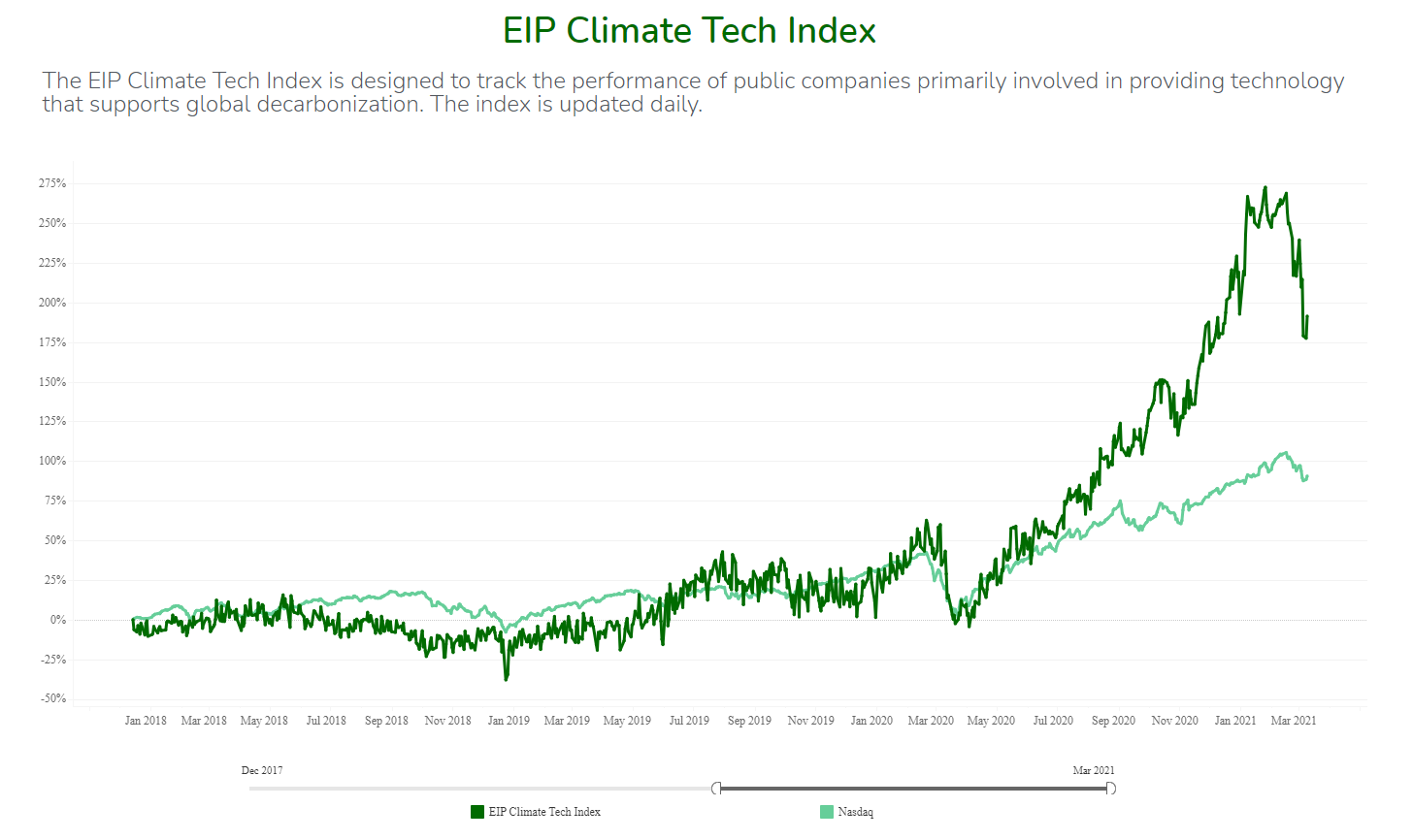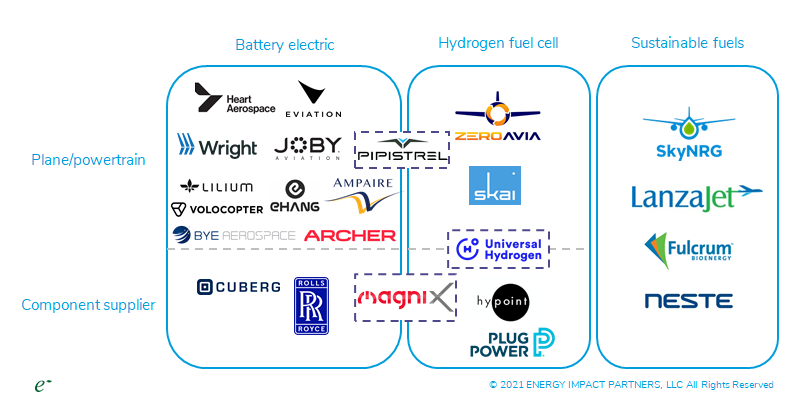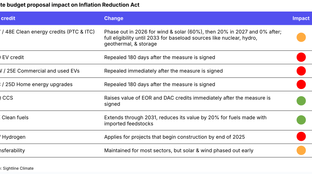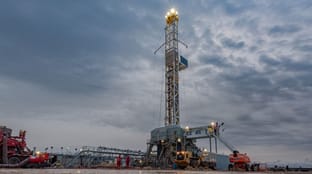
🌎 Overheard at LCAW #252
Climate, capital, and carrots in London's new playbook
The runway for zero-carbon aviation and an epic return from EIP’s Climate Tech Index
Happy Monday! We’re writing from a Hawaiian eco-retreat, please attribute errors and typos to our newfound zen - namaste.
In this week’s guest feature, EIP’s Madison Freeman walks us through the countdown to a zero-carbon takeoff; namely, battery electric, hydrogen fuel cell, and sustainable fuel aviation decarbonization pathways. There’s a fleet of promising start-ups, particularly in the smaller regional jet category, on the runway to erase the 2-3% of global emissions from air travel. Buckle up!
EIP’s Climate Tech Index also takes flight, soaring to ~200x returns since our first CTVC issue. In the news this week - the largest corporate DAC purchase and a cowboy-worthy interview on Chris Sacca’s ‘unretirement’ into climate venture investing. Thanks for reading!
Not a subscriber yet?

Energy Impact Partners (EIP), a climate tech venture capital firm backed by the largest energy consumers and utilities in the world, launched an index that tracks the performance of climate tech stocks listed on public markets.
Existing “climate” indices only track clean energy companies. EIP Partner Shayle Kann explains, “We wanted a single place to track the performance of climate tech companies in the public markets and couldn’t find one, so we created one. We wanted it to be broad and inclusive, ranging from mature companies to SPACs and from solar tech to fake meat.” Companies on the EIP Climate Tech Index run the gamut from alternative proteins (Beyond Meat), to renewable energy (Sunrun), to battery storage (QuantumScape), to hydrogen vehicles (Nikola), etc.
The EIP Index is crushing the NASDAQ by more than 2X as of yesterday - even after investor jitters over rising interest rates and budding bubble consensus brought stocks down to earth from a peak of 272% in January. Though the illustrative index is not structured for public investment, as Techcrunch pointed out, it’s greenfield territory for an enterprising investor to create a climate tech ETF based off of the index.
Just saying - if you’d bought the index when issue #1 of CTVC was published, your portfolio would have returned 200%+. 😜
🌱 Infarm, a Germany-based indoor farming startup, raised $100m in Series C funding from Hanaco Ventures and Atomico.
⚡ Skeleton Technologies, an Estonia-based maker of ultracapacitor-based energy storage systems, raised $61m in funding from Germany’s Federal Ministry for Economics Affairs and Energy.
🏍️ Damon Motors, a Canada-based developer of electric motorcycles, raised $24m in funding from Benevolent Capital, SOL Global Investments and Zirmania.
⚡ H2Pro, an Israel-based green hydrogen production company, raised $22m in Series A II funding from Breakthrough Energy Ventures, IN Venture, Contrarian Ventures, Horizons Ventures and others.
🥩 Planted, a Switzerland-based plant-based meat startup, raised $18m in Series A funding from Vorwerk Ventures and Blue Horizon Ventures.
⚡ LO3 Energy, a Portland, OR-based provider of digital tools to utilities for distributed resources, raised $11m in Series B funding from Shell Ventures, Shikoku Electric Power, Braemar Energy Ventures, Sumitomo and Centrica.
🌊 Bedrock Ocean Exploration, a Brooklyn, NY-based ocean exploration startup, raised $8m in Seed funding from Eniac Ventures, Primary Venture Partners, Quiet Capital, and R7.
💨 Plan A, a Germany-based platform for corporate carbon footprint tracking and reporting, raised $3m in Seed funding from Demeter, Coparion and SoftBank.
⚡ Copper Labs, a Boulder, CO-based energy management startup, raised $2m in Seed funding from National Grid Partners, Blue Bear Capital, Moonshots Capital, and Bull Creek Capital.
Active Impact Investments raised $41m for their second climate tech fund.
[We’ve edited the newsletter version for length; visit our website for the full feature]
In the throes of the pandemic, air travel took the hardest hit as we all hunkered down in our Zoom bubbles. Now that we can see the light at the end of the tunnel, the aviation industry has been busy not only adapting to a post-COVID world but also a climate change-impacted one. In the past few months, airlines, aerospace manufacturers, airports, and aviation startups alike are catching the decarbonization hype that has pervaded their transport peers on the ground.
A few weeks ago, Europe’s aviation sector revealed its ambitious plan, “Destination 2050” to reach net zero by 2050. Other major airlines like oneworld’s 13 member airlines (which includes American Airlines, British Airways, and Japan Airlines) have also committed to a 2050 target. United Airlines has even gone a step further by committing to meet its 2050 goal exclusively through direct air capture and SAFs (sustainable aviation fuels) and without any carbon offsets. Meanwhile, major aircraft manufacturers Boeing and Airbus have taken contrasting pathways to decarbonization with Boeing pledging that all its aircraft will run on SAFs by 2030 and Airbus releasing three zero-emission hydrogen aircraft designs which could enter service by 2035.
What’s even more exciting (and what we’ve been tracking) is the new crop of startups emerging to pursue electric or hydrogen flight. Within the last few months, the electric aviation sector has been taking off with SPACs, fundings, and acquisitions. While these sci-fi looking aircraft seem far away, many of these startups are targeting commercial operation in the next few years. TBD on whether their visions all come to pass, but we could all be taking some form of zero-carbon flight by the end of the decade.
SPACs: Archer Aviation and Joby Aviation, both startups developing eVTOLs (electric vertical takeoff and landing), announced they’re SPACing at $3.8B and $6.6B respectively. Lilium, another eVTOL startup, is also reportedly on the verge of SPACing at a $2B valuation.
Fundings: ZeroAvia, which is pursuing the hydrogen-electric pathway, announced a $21.4M funding round led by Breakthrough Energy Ventures. Volocopter, (yet another) eVTOL company, raised $241M in a Series D round from BlackRock and others.
Acquisitions: Ampaire, a hybrid aviation startup, will be acquired by Surf Air, a subscription-based air travel provider, with plans for the integrated company to go public later this year (another SPAC..?). Cuberg, a battery startup targeting aviation applications with an energy-dense lithium metal chemistry, will be acquired by NorthVolt, a Swedish battery manufacturer.
The decarbonization challenge of aviation is massive and far from being solved. Air travel accounts for 2-3% of global CO2 emissions and 12% of transportation-specific emissions - but even as other sources of emissions are on track to plateau or decline, aviation emissions are forecasted to grow dramatically as air travel demand is expected to triple by 2050. Planes also release NOx emissions and particulate matter that create contrails, both of which may more than double the warming impact of aviation emissions.
Achieving decarbonization for the aviation industry will be much more challenging compared to ground transport. The industry has primarily focused on efficiency and operations improvements and offset purchases over radical technology changes. But reductions from efficiency improvements would be more than negated by growth in demand for air travel (see pg 15 of the EU commission’s report). To reach net-zero, SAFs and “radical technology” adoption will be necessary to drive down the remaining emissions.
Aviation is already a feat of engineering and a delicate balancing game between power and weight. While ground vehicles can experiment with a range of weights and sizes, the physics of aviation put narrow constraints on feasible craft. Replacing jet fuel combustion will require a major leap in propulsion technology or a breakthrough in low to net-zero carbon replacement fuels.
Startups are currently making significant progress in battery electric and hydrogen fuel cell planes that seat 20 or fewer passengers and could take off in the next decade to service short routes. Larger aircraft may pursue hydrogen combustion down the line, but in the immediate future most large commercial operators will likely seek out SAFs to address emissions. Because designing a new aircraft can take decades, existing aircraft can stay in service for nearly half a century, and certification of new commercial craft is a long and arduous process given the safety implications. Getting aviation to true net zero by mid-century will require turbocharging radical technology breakthroughs,

Battery Electric: As electric vehicles have become the assumed transition pathway for all light-duty vehicles, with major automakers planning to only produce electric vehicles by 2030 and 2035, many have looked to mobilize the lessons learned from EVs into making electric planes.
The biggest challenge for electric aviation is in battery weight (or more accurately, gravimetric density). The batteries we have today work well for most passenger vehicles on the road, but for aircraft, each pound of battery means more work is needed to get off the ground and stay in the air. Though estimates of necessary battery density vary widely based on the type of plane evaluated and the length of route, most analyses agree that it’s unlikely (if not physically impossible) to achieve the density needed for widespread long-distance flight from lithium-ion batteries.
Today’s batteries may work well for short flights in smaller planes, but a longer trip (say, Los Angeles to NYC) will almost certainly require a breakthrough in battery chemistry, like those promised by solid-state battery makers like Quantumscape or lithium metal batteries like Cuberg.
Innovators: Heart Aerospace, Eviation, Wright Electric, Ampaire, Bye Aerospace, Joby Aviation, Lilium, Volocopter, EHang, Archer Aviation, Cuberg, Magnix
Hydrogen: Using hydrogen as fuel solves two key problems for aviation, as it produces only water vapor when combusted and is extremely lightweight. Hydrogen aviation startups today are pursuing hydrogen fuel cell applications for smaller planes, but larger efforts like the aircraft Airbus has floated could be powered by direct hydrogen combustion.
The biggest challenges facing hydrogen aviation are fueling infrastructure at airports and managing the volume of hydrogen in an aircraft. Though electric aviation would necessitate that airports install charging infrastructure and possibly make upgrades to grid infrastructure, hydrogen aviation presents a further challenge in sourcing hydrogen and managing refueling. Airports will need to either bring in hydrogen by pipeline or truck or generate it onsite, and then manage storage at the airport and fueling at the gate.
Though hydrogen is far more gravimetrically dense (lighter weight) than batteries, it faces a different density problem in its volume. Tanks of gaseous hydrogen start to displace space inside the plane, and larger craft will need to shift to liquid fuel (which presents additional fueling challenges), start directly combusting the hydrogen instead of using fuel cells, and/or lengthen the body of the aircraft. As hydrogen combustion isn’t currently feasible at a certain size of long-range craft, hydrogen’s sweet spot will likely be in small regional to mid-size aircraft.
Innovators: ZeroAvia, Universal Hydrogen, Hypoint, Skai
Sustainable Aviation Fuels (SAFs): SAFs promise a drop-in substitute for regular jet fuel that has significant emissions reductions but require no retrofit or redesign of existing aircraft. Their ability to be used immediately means that they could help tackle emissions as alternative propulsion technologies are being scaled up. SAFs have been embraced by airlines as the primary decarbonization pathway, and will likely be the only solution for long-distance flight in the foreseeable future.
SAFs can be biofuels (made from organic matter like corn) or synfuels (produced from CO2 and hydrogen using electricity). The climate impact of SAFs varies fairly widely based on how they are created, and SAFs generally can offer somewhere between 30-80% CO2 emissions reductions over jet fuel. The major hurdle for SAFs is securing reliably low-cost and environmentally sound sources. SAFs have been around for more than a decade, but remain far more expensive than comparable jet fuel (estimates suggest 2-3x the cost of jet fuel). Some of this will be mitigated as production scales, but they will likely always face some price penalty. Biofuels are cheaper than synfuels but present problems with sustainable sourcing, since the supply can compete with food production (corn) or be linked to deforestation (palm oil). Synfuels from CO2 would promise to solve that, but are still very early in development.
So far, SAFs are the only technologically feasible route to decarbonize long-distance flight and it will require big subsidies or policy support to help bridge the initial cost differential and make this economically feasible.
Innovators: SkyNRG, Lanzajet, Fulcrum Bioenergy
Readers who have followed the activity mentioned above may have noticed that the majority of the aircraft startups are pursuing very small planes, most below 19 seats - a far cry from the planes flown on major routes. These smaller planes make up ~4% of the global aircraft fleet and contribute less than 1% of aviation emissions. They are an important entry point for proving decarbonized flight, and many startups plan to displace the use of larger aircraft in regional travel with small electric/ hydrogen planes through innovative business models:
eVTOL (2-6 seats): eVTOL startups are seeking to build an entirely new business around “air taxis,” replacing ground vehicles on congested routes less than 50 miles. eVTOLs have other more realistic pathways to commercialization, replacing small cargo aircraft on existing routes or being deployed in military missions (the U.S. Air Force is particularly interested).
Small regional aircraft (9-40 seats): While many short routes today are served by large aircraft, several operators have argued that they would prefer to use smaller planes to run these routes more frequently - but because existing smaller aircraft are incredibly inefficient, they feel forced to operate large aircraft to make the cost per seat mile work. Several regional airlines like Cape Air have signed LOIs to purchase electric or hydrogen aircraft.
Single and double aisle aircraft (100+ seats): There are many traditional manufacturers of small to medium aircraft, but above 100 seats, the field narrows and is dominated by Boeing and Airbus which are starting to look at SAFs and hydrogen as potential decarbonization pathways.
Shopify announced the largest corporate DAC purchase ever for 10,000 tonnes of permanent carbon dioxide removals from Carbon Engineering. It’s welcome - but odd - that online payments companies (+Stripe) with far fewer emissions are leading the charge with these deployment purchases to drive down the carbon removal cost curve.
Only 18% of pandemic economic recovery spending from the world's 50 largest economies can be considered "green" per new analysis from the UN and the University of Oxford.
Speaking of which, Biden’s “Rescue” bill only indirectly mentions climate through state and local government earmarks for water, sewage, and broadband improvements. A highlight: the $5b commitment for disadvantaged farmers which some are calling the most significant piece of legislation for Black farmers since the Civil Rights Act.
Michael Regan, the former top environmental regulator in North Carolina, was approved as the country’s first Black EPA Administrator and aims to build back the gutted department to spearhead the Biden Administration's environmental policies.
The Interior Department completed its final environmental review of Vineyard Wind, clearing a key hurdle for the first US commercial scale offshore wind farm and charting the course for other offshore wind projects in the pipeline.
The energy innovation wing of the DoE, ARPA-E awarded $18m to four projects to reduce vehicle energy consumption through its NEXTCAR program. Separately, with its significant energy and vehicle fleet footprint, the DoD established a working group on climate change.
Chairman Jeff tasked the former CEO of World Resources Institute, Andrew Steer, with “steering” the deployment of the $10b Bezos Earth Fund.
FedEx is delivering on all-electric by 2040, injecting $2b into the effort. After its limited electrification commitment “duckbackle,” USPS may be getting $6b from Congress as part of a reactive newly proposed bill requiring all new USPS vehicles to be zero-emissions after 2040.
From pedal to heavy metal - Gomi dropped the mic with the world’s most sustainable speaker made from recycled plastic bags and powered by old Lime e-bike batteries.
Meanwhile, Canoo’s funky looking electric pickup is honestly just adorable.
Chris Sacca dusts off his spurs and cowboy language in a meme-worthy and inspiring chat with Forbes about his “unretirement” to focus on climate investing at Lowercarbon Capital.
Patrick Collison, CEO of Stripe, discussed the future of technology in an interview and called out energy technologies like batteries and renewables as one of the three tech trends that excite him the most.
How long will it be until every car is electric? Longer than you might think.
Two EU climate tech lists! 900+ startups from SpeedInvest and Creandum, and an AirTable of VCs to fund them from Amasia.
💡 For ClimateTech Global Innovation Challenge: Apply for the opportunity to win $10,000 and office hours with climate experts at AWS by March 18th.
💡 Blueprint: Graduate or research students can apply by March 26th to join The Engine’s program that helps the next generation of Tough Tech leaders navigate the commercialization process.
💡 Penn Climate Ventures Prize: Open to all students from high school to grad school; register to attend by March 29th for industry panels, keynotes, and a chance at mentorship and non-dilutive funding.
🗓️ Wall Street in the Wilderness: On March 16th Ricardo Bayon, investor at Encourage Capital, will interview Mark Tercek about his journey from Goldman Sachs to head of The Nature Conservancy.
🗓️ Cleantech & Sustainability Shaping Cities: Women in Cleantech is hosting a panel on sustainable cities on March 25th featuring Charlotte Matthew, Director of Sustainability at Sidewalk Labs, and Tiffany Chu, CEO of Remix.
Associate @Pillar VC
Investment Professional @Renewal Funds
Associate, Innovative Finance @Rockefeller Foundation
New York Director @Building Decarbonization Coalition
Senior Policy Advisor @Carbon180
Carbon Removal Hardware Lead @EquiOpps
Data Analyst, Scientist, SE @eIQ Mobility
Software Engineer @Running Tide
Feel free to send us new ideas, recent fundings, or general curiosities. Have a great week ahead!

Climate, capital, and carrots in London's new playbook

US plays popcorn politics with biofuels and beyond

Groundbreaking results from the geothermal developer’s main project